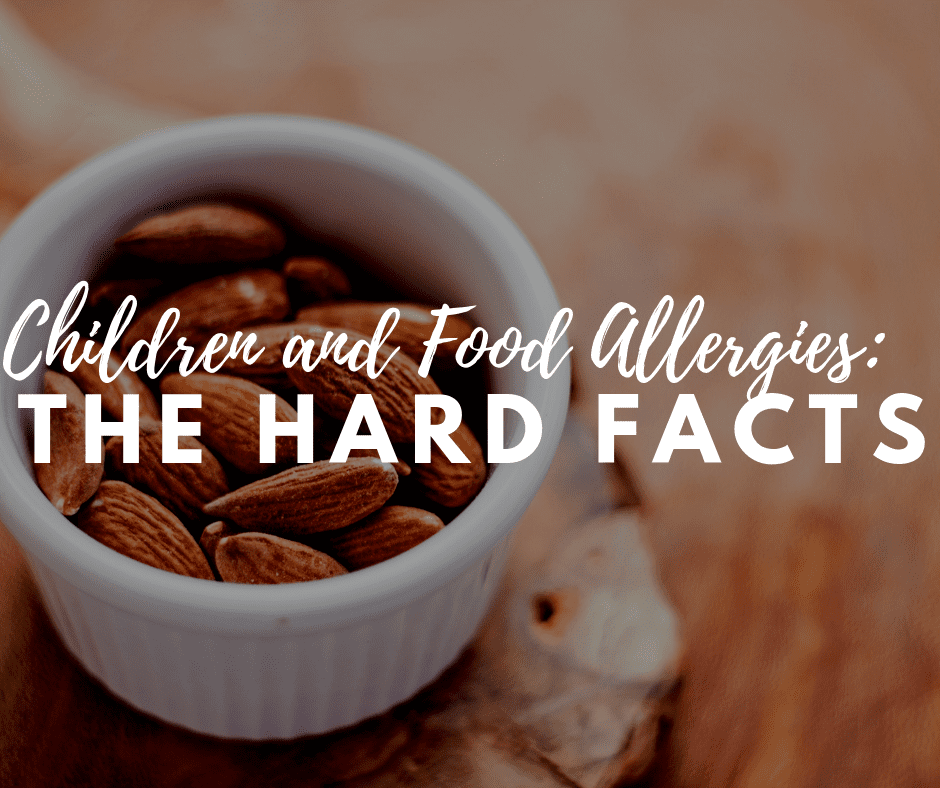

Food Allergies and Children: The Hard Facts


1 in Every 13 Children Have Food Allergies.
That’s 5.9 million children. And in just over a decade, the prevalence of food allergies in children has increased by a whopping 50%.
But this population study was done almost a decade ago. Imagine the numbers in 2019.
As a nutritional therapist, I see an uptick in allergies with my clients. As a mom, I also see it in the day to day. This year, my son’s preschool implemented a “bring your own snack” rule—too many children with food allergies for the school to keep up with.
Children’s food allergies are not just an inconvenience, they may cause financial stress, social isolation, increased prevalence of bullying and higher risks of eczema and asthma. With the possibility of life-threatening reactions, stress and anxiety just scratch the surface of what we go through as moms.
Maybe it’s because we feel helpless to these food allergies—allergic reactions can strike in a matter of minutes to hours of being exposed to even trace amounts.
Exposed. Not ingested—exposed.
My son breaks out in hives when he eats “something wrong.” My son has also been to the ER for an epileptic seizure (their body’s innate reaction to help control, rapidly rising fevers).


An hour after dinner, our son broke out in hives everywhere and his face began to swell. My heart raced as I searched for allergy medicine. The meds helped lessen the symptoms but we never figured out what food caused the reaction.
But learning as much as I can about food allergies, has allowed me to feel better prepared and in turn, a sense of comfort that it’s going to be okay. Here are some tips that I’ve found helpful.
The 8 Major Common Food Allergies and Sensitivities:
- Milk
- Egg
- Peanuts
- Tree nuts
- Wheat
- Soy
- Fish
- Crustacean shellfish
- Sesame—new emerging allergy
Most food allergies start in childhood and some allergies are outgrown in adolescence. Peanuts, tree nuts and shellfish usually remain lifelong food allergies.
Signs of Food Allergy Reactions:
Our body’s immune system will show symptoms (allergens) when it sees foods as harmful. It is our body’s way of protecting our selves from foreign matter.
- Tingling or itching in the mouth
- Swelling of the lips, face, throat, tongue, ears and/or other parts of the body.
- Trouble breathing, wheezing, or nasal congestion
- Abdominal pain, diarrhea, nausea or vomiting
- Dizziness, lightheadedness or fainting
- Anaphylaxis – severe allergic life-threatening reaction. Requires emergency treatment. (epinephrine, ER visit)
Common Locations for Allergic Reactions:
- School (15% of children with food allergies had a reaction at school.)
- Restaurants and food establishments (especially for peanut and tree nut allergies)
- Commercial airlines (from peanut and tree nut ingestion, contact and/or inhalation).
Prevention for Food Allergies:
Unfortunately, there is no cure for food allergies or food sensitivities. Prevention is key.
- Identify Any Food Allergens for Your Child.
You can introduce your child to a new food (with other “safe” foods) for several days. Check to see if your child has any allergic reactions.
- Check the Food Labels.
Knowledge is power here. The more you understand the ins and outs of an allergic food, the easier it will be to play offense.
Let’s run through an example: Soy.
If your child is allergic to soy, checking labels for “soy” is not enough. Soy is in edamame, tofu and the obvious soy products, such as soy milk and soy sauce. But soy is also in cereals and crackers, hydrolyzed plant proteins (HPP), imitation dairy food, infant formula and children’s nutrition supplements.
When in doubt, leave it out.
- Ease Up on the Antibacterial and Fear of Dirt.
Fact: Children from rural communities are less likely to have food allergies than children from urban centers.1
Why?
As a nutritional therapist, I tend to see a correlation (may not be causation) with the overuse of antibacterial products and antibiotic usage and the adverse effects on our gut biome (the healthy bugs in our gut). If your child has taken antibiotics, I recommend a good quality prebiotic and probiotic.
- Add in Some Prebiotics and Probiotics.
Probiotics contain live microorganisms intended to support the good bacteria in our body. Prebiotics are dietary fibers that act as a fertilizer for good bacteria in our bodies. Bone broth is also a superfood for gut healing.
Stay away from sugary foods with “probiotics.” Sugar negatively counteracts with probiotics. (e.g., highly processed yogurts).
- Eat Wholesome Real Foods.
Eat wholesome real foods instead of processed foods with possible hidden allergens. Wholesome real foods have more nutrients per calorie and will support the healthy growth of our children’s bodies.
If you’re child has been diagnosed with food allergies, just take a moment. It’s going to be okay. Learn as much as you can and talk with others. The beauty in all this ugly, is that you aren’t alone. Find families with similar food allergens, talk and connect.
Healing comes with knowledge, love and community.
If you want to learn more, here’s a great fact sheet.
If you are starting your child in school, here’s a great sheet for school planning tips.



